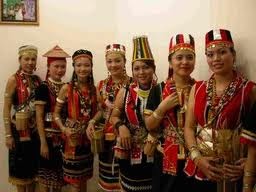Dayak Bidayuh tribe is a sub-tribe of the Dayak tribe Klemantan grove which is a sub-part of a group Ribunic / Jangkang comprising Ribun Dayak, Dayak Pandu, Pompakng, latitude, Pangkodatn, Jangkang, (Simpanbk) etc..
ceremonial nyobeng
Region of domicile
The Dayak Bidayuh are one of the seven tribes of the Dayak in Kalimantan (Murut, Banuaka, Nganju, Iban, Kayan, Ma'anyan, Bidayuh), which most of its population cover Sanggau districts, Ketapang, and some spread in the region and Bengkayang Sekadau . The Dayak Bidayuh are also numerous in the area Noyan, Kembayan, Sanggau, Sanggau. In the village of Cape Pigeon, Ngalok, Mobui, Sejuah, Bun River, Tanap, and surrounding villages is the basis of this Bidayuh.
There are some experts who had examined the origins of this Bidayuh. But, none of the authentic and involving all joints kehidiupan Bidayuh community. According to Prof. Richard McGinn Dayak Bidayuh have a close kinship with Bukar-Sadong Dayak tribe. Both Dayak tribe has a kinship with his brother tribe also Rejang of Sumatra. That is why in Sarawak is the name of the Rejang River, while in Sumatra is the name of spare Rejang. Their ancestors lived among the three rivers namely Rejang rivers, streams and rivers Bukar Sadong. Why and how? Dayak Bidayuh tribal brothers and Bukar Sadong, the Rejang tribe is in Sumatra, still need further study?.
Livelihood Most of the livelihood is farming switch, rubber farmer, handyman. Only a small proportion who work as government officials and merchants, especially government officials. Only in this decade there are several local men who occupy important positions in government. The main reason for the livelihood so is the lack of access to science and technology and the lack of educational facilities there. Imagine, the kids have to walk as far as tens of kilometers on foot to reach the access to education. Not surprisingly, many parents are more concerned with the economic needs rather than education.

There is one interesting thing from the life of Dayak Bidayuh community. Natural conditions that do not support agricultural businesses responded with open farm fields, to later be burned. this is done to menggemburkan soil. Such a state of nature offset by a variety of forest plants that can be used as food, especially fruits. Bidayuh community very rarely consume vegetables. Daily food is rice and side dishes prepared themselves, with spices typical of Dayak. Their diet is dominated by salty and sour taste. When the fruit season arrives, most of the profession changed to impromptu fruit farmers. Usually the fruit is picked from the forest brought Afternoon reserved for sale. They have known the money just like us.
Religion The majority of the Bidayuh population adheres to Catholic Christianity, the rest are Protestant, while hardly embraced Islam at all, is because that the teachings of Islam forbid pork, while it outlines the life of Dayak people associated with pig meat as food. Chinese ethnic majority there has been interbreeding with the natives.





















